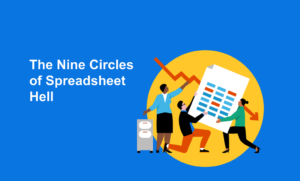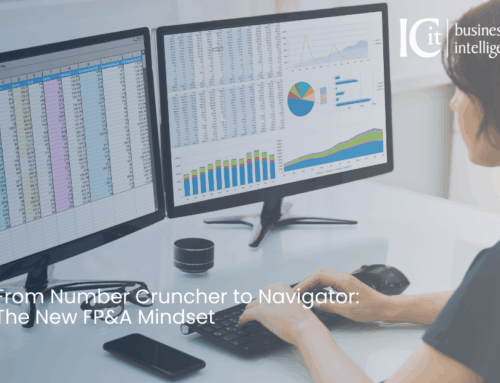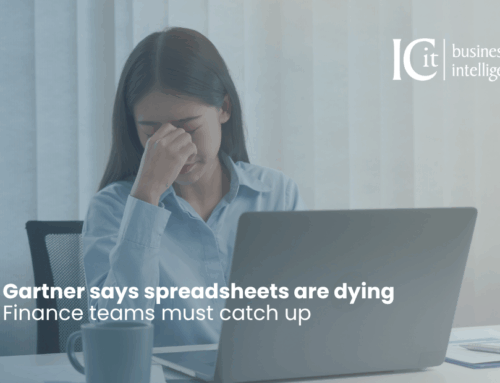Manual spreadsheets simply aren’t powerful or fast enough to enable comprehensive, continuous planning. And without that, you can’t keep up with the pace of modern business. This is why some FP&A specialists use the phrase “spreadsheet-itis.” It’s not only that spreadsheets involve cumbersome and untimely reporting, but they also can deny managers and employees a single, unified view of vital data—one version of the truth.
Problems with maintaining undocumented or documented spreadsheets also occur when the employee who developed the spreadsheet transfers elsewhere in the organisation or departs it altogether.
Here are five signs organisations have outgrown spreadsheets
Sign #1: Manual processes that hamper company-wide planning
Depending solely on spreadsheets keeps finance teams mired in manual processes, overburdened with approaching deadlines, and stuck investigating broken links and errors.
There may be good spreadsheet reports within a given department, but generally the rest of the organisation is not aware of them. Additional pain results when other departments re-create their own version of the same report—a wasteful duplication of effort. With multiple spreadsheets, when data differs, which are the right numbers?
Even non-profits like Goodwill Industries aren’t immune to these issues. Goodwill relied on business managers across the organisation to provide information for budgets and forecasts. As more people got involved, it became nearly impossible to ensure that the consolidated sheets were accurate and aligned, and company-wide planning became a huge challenge.
Today, Goodwill uses a cloud-based budgeting solution that includes everyone in a comprehensive, continuous planning process that automates calculations, supports self-service reporting, and frees finance to help drive strategy, not just run reports.
Sign #2: Long budget cycles and out-of-date numbers
The time it takes to generate, share, and maintain reports every month is one of the biggest burdens of manual spreadsheet reporting. By the time you’ve gathered all the numbers, fixed formulas, and created an annual plan, your numbers are likely out-of-date.
Take for example Barry University, a private college in Florida. With over 100 managers, 15 teams, and 150 business units, the university previously took between five and six months to prepare the budget, generating hundreds of spreadsheets and creating confusion and chaos.
Barry University eventually turned to a cloud-based planning software solution that dramatically decreased budget cycle times, increased accuracy, and aligned departments behind the same source of data.
Sign #3: Infrequent forecasts and budgets
Annual budgets and disjointed processes can’t keep up with today’s fast-paced business environment. Budgets are out-of-date soon after they are published. And quarterly forecasts are routinely obsolete by the time they’re finalised.
GDF Suez North America (GDF), a multinational utility company, discovered the limitations of manual spreadsheets first-hand. The budget team used spreadsheets to manage 125 legal entities within an $8 billion revenue division. The time it took to budget and run models in a fluctuating energy market created a substantial lag between budget creation and implementation.
GDF turned to a cloud-based, continuous planning solution it could implement across 50 North American locations. Freed from the limitations of a spreadsheet-only approach, the finance team now creates frequent forecasts that keep budgets on track.
Sign #4: Too many systems, not enough integration
Budgeting would be hard enough if keeping numbers current were the only challenge. For the determinants and source variables used in the budget process, finance teams also have to collect data from many different systems (e.g., HR, ERP, CRM, etc.). Spreadsheets alone might have worked five years ago. Not anymore.
When data is stored on employees’ computers (e.g., a laptop or personal computer) rather than on a server or a web-accessible source, dissemination and analysis becomes more difficult. Non integrated data means that assumptions in one person’s plans will likely not include the most recent version from someone else’s assumptions and plans. Most spreadsheet users have a widely held misconception that their spreadsheet application is some sort of database. It is not. It is a calculator effective at manipulating and viewing data, but it is not particularly good at storing and managing it in a reliable, secure, scalable way.
DocuSign, a provider of cloud-based electronic signature solutions, was initially able to manage financials only using spreadsheets. But as DocuSign grew, those spreadsheets became unmanageable. To top it off, its systems were not integrated, which made comprehensive planning a huge challenge.
DocuSign turned to a planning solution that integrated its ERP and salesforce management software so finance could generate the robust transaction-level reporting and budgeting the growing organisation needed.
Sign #5: Only finance and IT can run reports
When IT and finance are the only ones who can run what-if scenarios and complex queries, they become a bottleneck, which makes it difficult to create timely ad hoc reports. Even the most detail-oriented manager might get caught flat-footed if an executive asks a question about a specific line-item overrun or a revenue variance due to fee increases.
Papyrus, a greeting card and stationery retailer with 450 stores in the U.S. and Canada, relied on one finance team member to oversee the entire budget process. On top of managing 15 budget versions and 250 spreadsheets, finance was charged with providing ad hoc reporting for any and all queries that came in from managers and execs.
With a cloud-based planning solution, Papyrus decision-makers now have direct access to self-service reporting, which gives them greater insight into company performance and more confidence in the numbers.
This blog was originally published on the Workday Adaptive Planning Blog

This eBook outlines Excel’s nine biggest limitations, and how you can overcome them by moving to financial planning and analysis (FP&A) in the cloud.
Find out how you could free your finance team of spreadsheets in just 30 days, request a call with one of our Workday Consultants Contact us








